ECU SSANGYONG KORANDO 2012 Manual PDF
[x] Cancel search | Manufacturer: SSANGYONG, Model Year: 2012, Model line: KORANDO, Model: SSANGYONG KORANDO 2012Pages: 1082, PDF Size: 96.1 MB
Page 482 of 1082
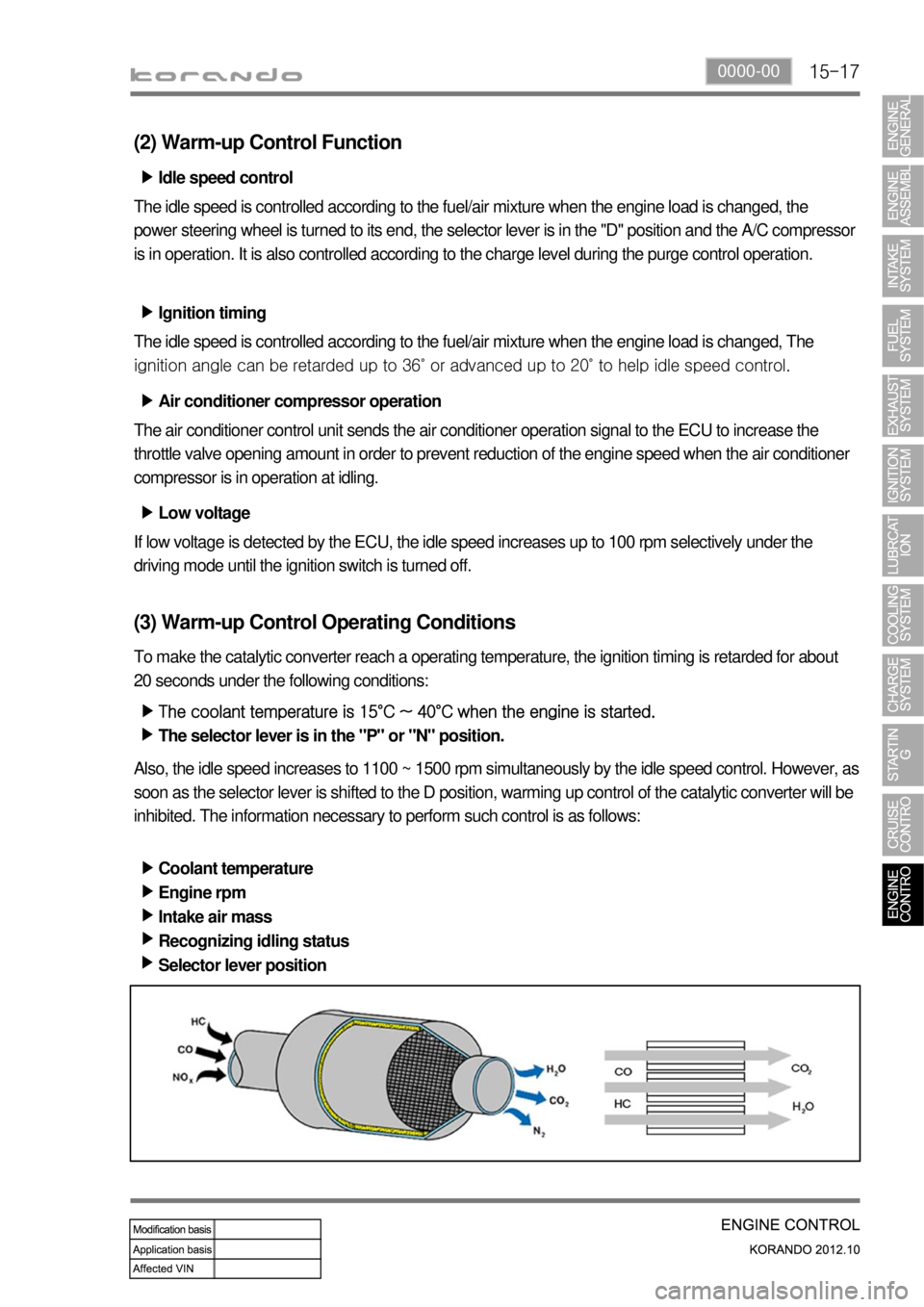
15-170000-00
(2) Warm-up Control Function
Low voltage ▶
If low voltage is detected by the ECU, the idle speed increases up to 100 rpm selectively under the
driving mode until the ignition switch is turned off. Idle speed control ▶
The idle speed is controlled according to the fuel/air mixture when the engine load is changed, the
power steering wheel is turned to its end, the selector lever is in the "D" position and the A/C compresso
r
is in operation. It is also controlled according to the charge level during the purge control operation.
Ignition timing ▶
The idle speed is controlled according to the fuel/air mixture when the engine load is changed, The
<0090008e00950090009b009000960095004700880095008e0093008c0047008a0088009500470089008c00470099008c009b00880099008b008c008b0047009c00970047009b00960047005a005d020b00470096009900470088008b009d00880095008a00
8c008b0047009c00970047009b0096004700590057020b0047>to help idle speed control.
Air conditioner compressor operation ▶
The air conditioner control unit sends the air conditioner operation signal to the ECU to increase the
throttle valve opening amount in order to prevent reduction of the engine speed when the air conditioner
compressor is in operation at idling.
(3) Warm-up Control Operating Conditions
To make the catalytic converter reach a operating temperature, the ignition timing is retarded for about
20 seconds under the following conditions:
The coolant temperature is 15°C ~ 40°C when the engine is started.
The selector lever is in the "P" or "N" position. ▶
▶
Also, the idle speed increases to 1100 ~ 1500 rpm simultaneously by the idle speed control. However, as
soon as the selector lever is shifted to the D position, warming up control of the catalytic converter will be
inhibited. The information necessary to perform such control is as follows:
Coolant temperature
Engine rpm
Intake air mass
Recognizing idling status
Selector lever position ▶
▶
▶
▶
▶
Page 483 of 1082
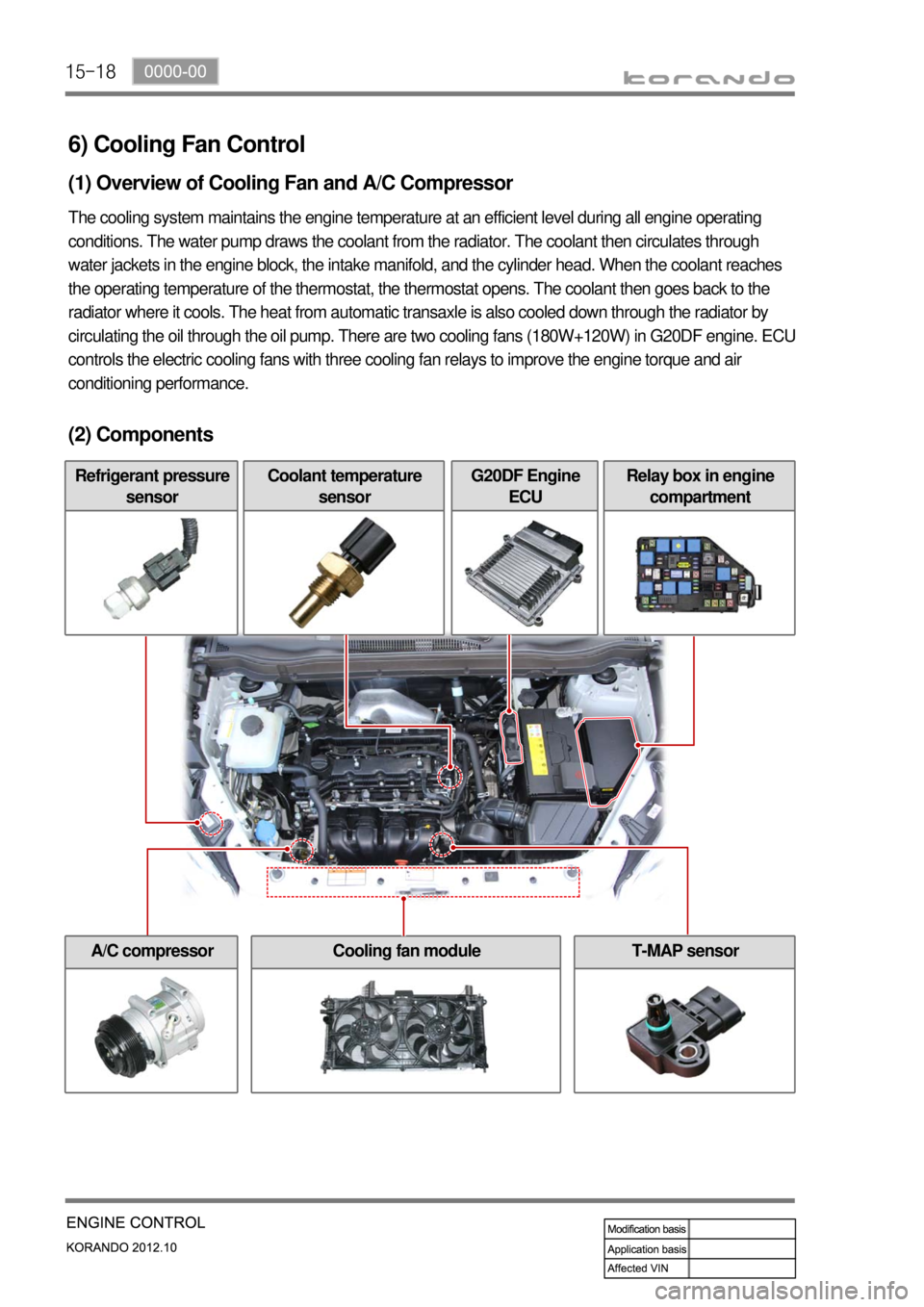
15-18
6) Cooling Fan Control
(1) Overview of Cooling Fan and A/C Compressor
The cooling system maintains the engine temperature at an efficient level during all engine operating
conditions. The water pump draws the coolant from the radiator. The coolant then circulates through
water jackets in the engine block, the intake manifold, and the cylinder head. When the coolant reaches
the operating temperature of the thermostat, the thermostat opens. The coolant then goes back to the
radiator where it cools. The heat from automatic transaxle is also cooled down through the radiator by
circulating the oil through the oil pump. There are two cooling fans (180W+120W) in G20DF engine. ECU
controls the electric cooling fans with three cooling fan relays to improve the engine torque and air
conditioning performance.
(2) Components
Refrigerant pressure
sensorCoolant temperature
sensorG20DF Engine
ECURelay box in engine
compartment
A/C compressorCooling fan moduleT-MAP sensor
Page 486 of 1082

15-210000-00
7) Immobilizer Control
(1) Overview
The Immobilizer System provides an additional theft deterrent to the vehicle in which it is installed and
prevents it from being started by unauthorized persons. The transponder integrated in the key and the
engine control unit have the same code. When the ignition key with the integrated transponder is turned
to the ON position, the ECU (Engine Control Unit) checks the crypto code of the key and, if correct,
allows the vehicle to start the engine.
For details, refer to Chapter "BCM".
(2) Components
Conditions for cooling fan ▶
Immobilizer
antenna
Immobilizer
key
Start motor
Instrument
cluster
BCM
G20DF ECU
Page 487 of 1082
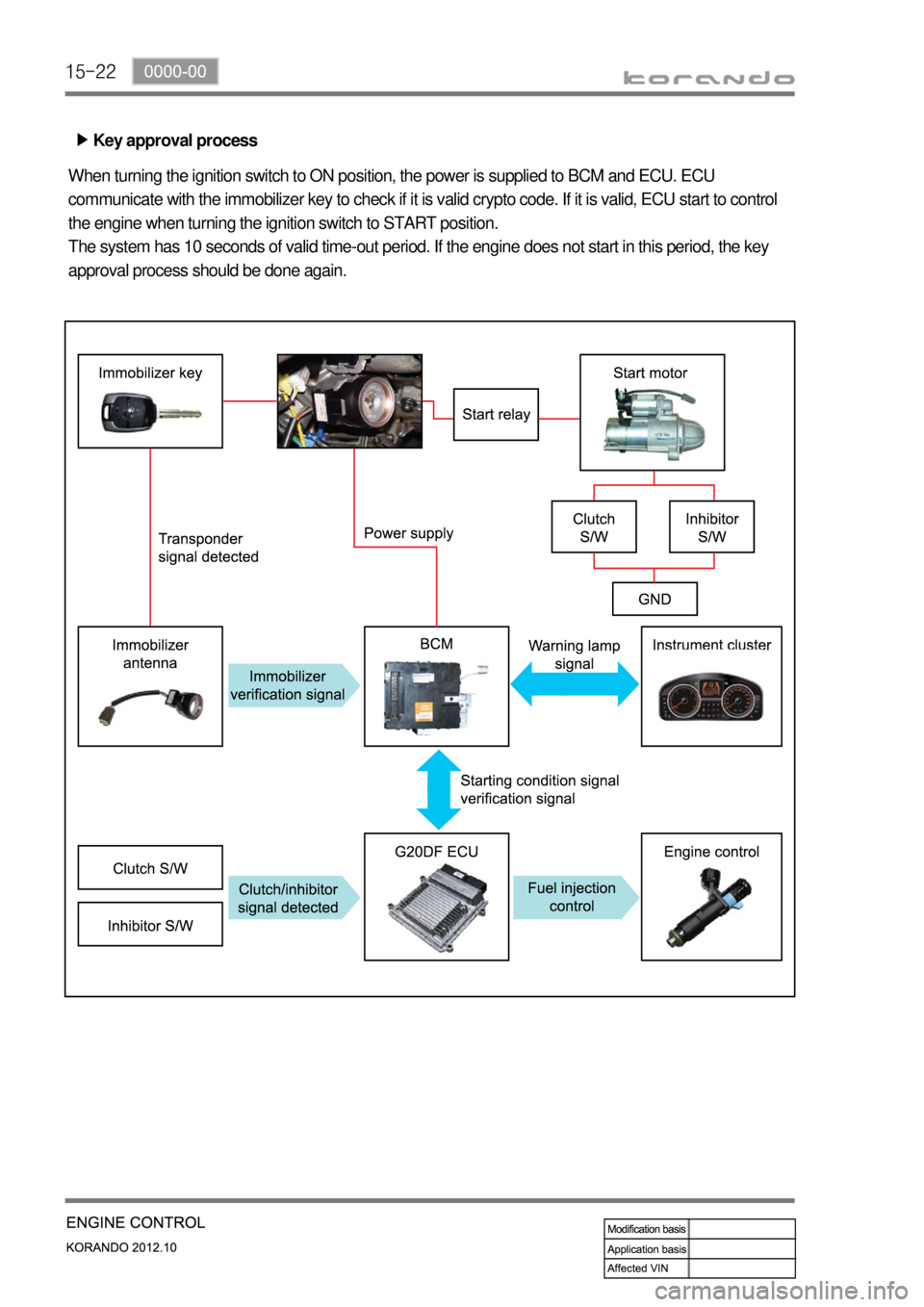
15-22
Key approval process ▶
When turning the ignition switch to ON position, the power is supplied to BCM and ECU. ECU
communicate with the immobilizer key to check if it is valid crypto code. If it is valid, ECU start to control
the engine when turning the ignition switch to START position.
The system has 10 seconds of valid time-out period. If the engine does not start in this period, the key
approval process should be done again.
Page 488 of 1082

15-230000-00
8) CAN Configuration (P-CAN/B-CAN)
(1) CAN Configuration (P-CAN/B-CAN)
Name Function
ECUElectronic Control Unit
TCUTransmission Control Unit
EPSElectronic Power Steering Unit
BCMBody Control Moudule
SKMSmart Key Moudule
CAN system communicates with the system units in vehicle. It consists of P-CAN and B-CAN according
to the communication speed.
P-CAN & B-CAN: SKM, Instrument cluster, BCM, Disgnostic connector
P-CAN: ECU, ABS & ESP, TCU, E-coupling, EPS unit
Terminal resistance: installed on ECU and BCM
Page 504 of 1082

02-50000-00
T-MAP sensor
TurbochargerCDPF
1. MAJOR COMPONENTS (D20DTF(Low CO2))
ECU
Intercooler assemblyAir cleaner assembly
Page 510 of 1082

14-4
2. COMPARISON
ItemDescription
D20DTF D20DTF (Low CO2)
Effective date From March, 2012
Applied engine D20DTF
Battery capacity 12V 90Ah
Alternator capacity Delphi 120A Delphi 140A
AlternatorChanged the diameter of belt pulley (Front view)
Changed the regulator and control logic (Rear view)
ECU Without EEM logic With EEM logic
EBS NoneMonitoring the battery conditions (voltage,
current, temperature and SOC)
Page 511 of 1082
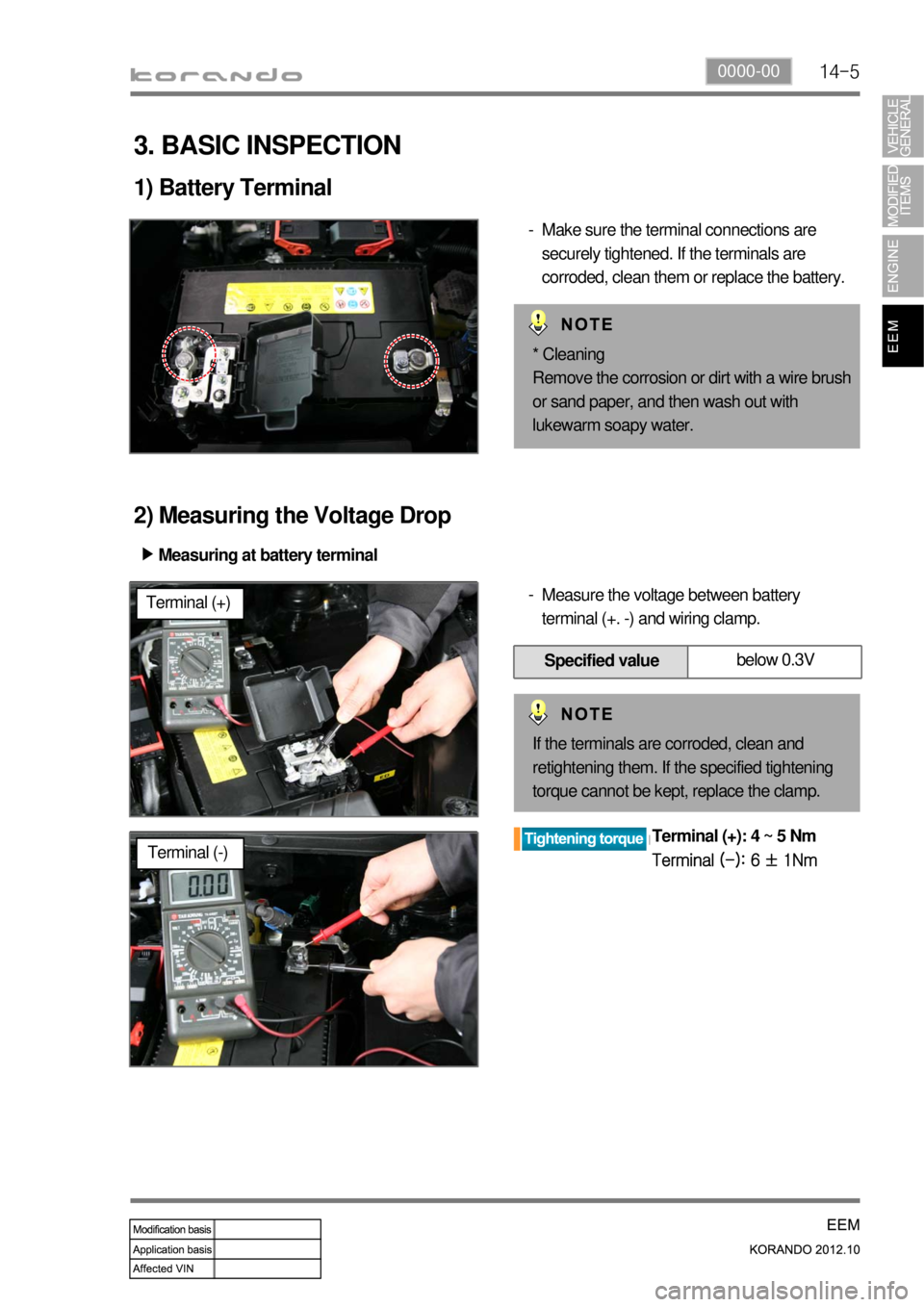
14-50000-00
3. BASIC INSPECTION
1) Battery Terminal
Make sure the terminal connections are
securely tightened. If the terminals are
corroded, clean them or replace the battery. -
* Cleaning
Remove the corrosion or dirt with a wire brush
or sand paper, and then wash out with
lukewarm soapy water.
2) Measuring the Voltage Drop
Measuring at battery terminal ▶
Measure the voltage between battery
terminal (+. -) and wiring clamp. -
Specified valuebelow 0.3V
If the terminals are corroded, clean and
retightening them. If the specified tightening
torque cannot be kept, replace the clamp.
Terminal (+)
Terminal (-)
Terminal (+): 4 ~ 5 Nm
Terminal (-): 6 ± 1Nm
Page 522 of 1082
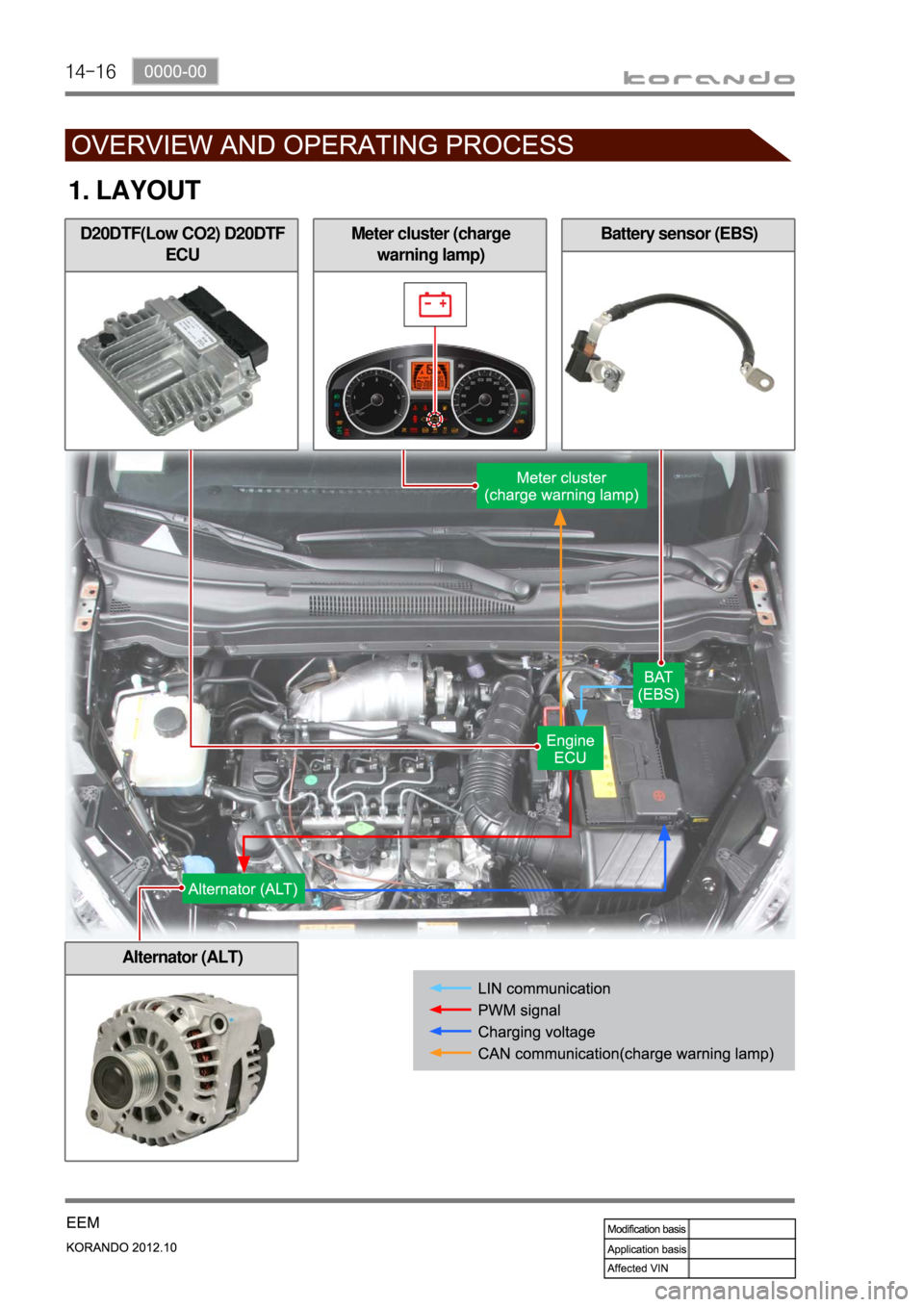
14-16
1. LAYOUT
D20DTF(Low CO2) D20DTF
ECUBattery sensor (EBS)
Alternator (ALT)
Meter cluster (charge
warning lamp)
Page 523 of 1082

14-170000-00
2. OPERATING PROCESS
System diagram ▶
Operation ▶
EEM monitors the electric loads and battery conditions and controls the voltage to improve the fuel
economy and battery charging efficiency.
EBS on “-“ terminal of battery sends the battery information (voltage, current, tem
perature and
SOC) to engine ECU with LIN communication.
Engine ECU outputs the information from EBS and regulating control signal (PWM) according to the
<008c0095008e00900095008c0047009300960088008b0047008a00960095008b0090009b009000960095009a0047009b0096004702c8007302c90047009b008c009900940090009500880093004700960095004700880093009b008c009900950088009b00
9600990055>
Engine ECU controls the magnetic resistance between stator coil and rotor coil by controlling the
current in rotor coil according to PWM duty value.
The alternating voltage induced to stator coil is converted to direct voltage by rectifier. And, EBS
<0096009c009b0097009c009b009a0047009b008f008c0047008a008f00880099008e00900095008e0047009d00960093009b0088008e008c0047009b0096004702c8006902c90047009b008c00990094009000950088009300470096009500470088009300
9b008c009900950088009b009600990055> -
-
-
-
-